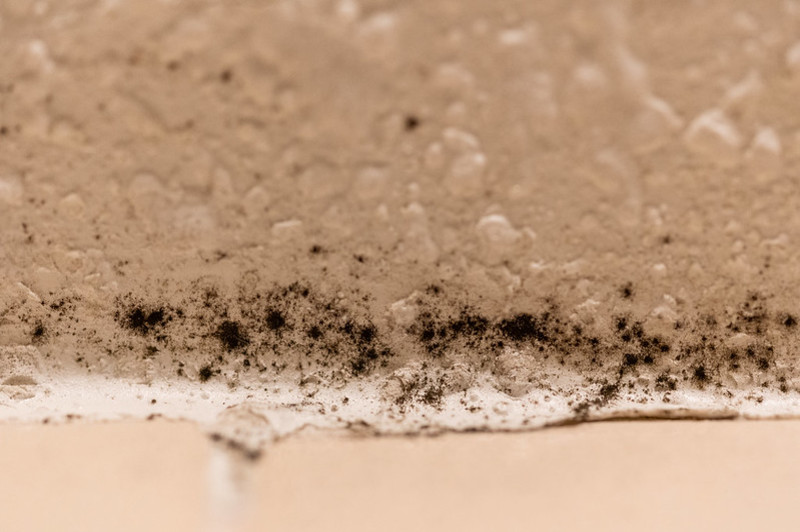Molds do not only appear in one color; some are in gray, white, or brown but this guide will specifically tell you the steps on how to identify black mold. You may be in dire need of this as black molds can not only be toxic to your home. It may also pose a possible health risk.

How Do You Spot Black Mold?
This type of mold typically appears in the damp areas of your home. It particularly grows around the air conditioning units, heating system, bathrooms and suchlike. Oftentimes, it also takes shape on your plasters.
So before learning how to seal your water damaged and mold infested plasters, there are factors you must consider. Location is one way to spot a mold but knowing the following signs may help you know if it is really a black mold you are scrubbing away.
1. Check its appearance
From the name itself, a black mold usually appears in dark color. This color may range from black, dark green or dark brown.
However, some come with a touch of orange or white. Either of these, the only common trait of this type of mold is its circular-shaped spot.
Other black molds have a slightly furry look. Huge amounts of mold may seemingly occur like a black stain stretching on your walls, floor, ceiling, or any other affected area. The essence of this step is to not let your scrubbing and drop of cleaning agent go to waste for mistaken spots.
2. Examine its smell
A distinct trait of any mold is its musty and earthy smell which is often compared to a decaying plant. If you smell something as described but does not spot any mold, try to inspect areas that may have been exposed to water leak or damage.
However, before you dive into using a fresh nose for this task, remind yourself to take safety precautions. Wear an N-95 mask or P-100 respirator to avoid the harmful effects of black mold to your respiratory system. This is particularly a must-have for people with high health risk.
3. Catch your response
Most of the time, the earliest sign that there is black mold lurking in your home is your response. If you catch yourself suddenly sneezing and coughing in a chronic manner or you experience eye and skin irritation or persistent headaches, it is most likely that you are dealing with a tell-tale sign of black mold.
The longer the black mold remains untreated, the longer your exposure will be. This also means that it may cause further respiratory problems. Symptoms for this may include nausea, vomiting, and nose bleeding.
Is All Mold That Is Black Dangerous?
It is important to remember that black molds are hazardous. Thus, you should tiptoe your cleanup around it or else you might get unwanted bodily reactions. However, the question of whether all black mold is dangerous or not still stands.
The color and toxicity of a black mold goes separately. This means that not all molds that appear in black are fatal.
Similarly, not all deadly molds merely appear in black. White mold usually looks like a white powdery residue, and its health issues are dependent on the individual.
Thus, before you deal with this mold with your scrub brush and cleaning agent, there are differences you should remember. Through this, you know which mold you should protect yourself from and which one does not really need much caution.
Black “colored” mold
A black colored mold is stereotypically associated with toxicity but that’s not exactly the case. It can be an allergen which apparently means that it can cause allergic reactions to someone with respiratory triggers.
Common media examples of which are Nigrospora and Cladosporium. These molds have been proven scientifically to be non-toxic. However, black molds such as Alternaria can cause severe bodily reactions.
Black “toxic” mold
Black toxic mold, on the other hand, differs from the former. These molds contain toxic chemicals called mycotoxins that are present in its spores. When these chemicals are released into the air and inhaled, it might lead to an unspeakable scenario.
An example of this is the Stachybotrys chartarum which not only comes in black but also in dark green. Be careful to come in contact with it in your attic as it commonly grows in this area and can be highly toxic.
Conclusion
At first, the question of “how to identify black mold” might seem like an easy peasy thing. However, with all the mentioned things that one must keep in mind when dealing with black mold, it is actually a quite daunting task.
This is not a mere black mold you are dealing with, whether it comes in tiny spots or huge stretches. This mold may be destructive to your home alone or to your health as well. You may initially think you are walking on eggshells and careful to not trigger anything, but with this helpful guide, all will go well smoothly.

How do I get some one to test for mold at the safehouse in safford az